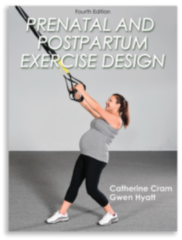When designing a prenatal fitness program the key components of intensity, duration, frequency, and mode are used, but specific modifications in the level of progression, supervision, and monitoring are needed in order to keep the exercise safe for mother and fetus. The goal of a prenatal exercise routine is to maintain or improve overall fitness, strength, and flexibility. Keep in mind that each woman’s fitness level and ability will vary, and as pregnancy progresses changes in her body will affect her ability to exercise comfortably.
Although there are general physical changes during each trimester, not every woman will experience the same limitations or have the same response to exercise as other women at that stage in pregnancy. Developing modifications to exercise routines that enable your client to comfortably continue with their exercise routines throughout pregnancy is an important goal for fitness professionals working with this population. Close monitoring and a reliance on a consistent feedback loop will ensure that you are providing a safe and effective fitness routine to your client.
Determining and Monitoring Prenatal Exercise Training Intensity
The use of a training heart rate to measure intensity during exercise has been determined to be a poor indicator of pregnant woman’s exertion level and here’s why:During early pregnancy, hormonally induced blood vessel dilation and the resulting vascular underfilling will cause a woman’s heart to beat more rapidly to make up for the drop in volume. If she exercises at her usual prepregnancy level, her heart rate response will be much higher than normal because of her body’s attempt to pump blood through her system. As pregnancy progresses, blood volume increases to correct the changes in circulatory volume, causing cardiac output to rise, but the continued physiological changes of pregnancy impact the heartrate response to exercise, making it a less accurate assessment of exertion.
Because of the pregnancy-induced changes affecting exercise heart rate response, the most accurate and safe way to gauge exercise intensity is to use the Borg Rating of Perceived Exertion scale (RPE). Pregnant women should exercise at a level that feels moderate to somewhat hard (12 to 14 on the 20-point scale or 3 to 4 on the 10-point scale). Some women may not be able to accurately gauge their RPE level, especially if they are just starting an exercise program, so it’s recommended to use the “talk test” a simple tool for gauging exertion. Instruct the client to avoid exercising to the point where they are unable to carry on a conversation (if they’re so out of breath that they cannot talk, it is a sign that they are working past the advised Borg rating range for pregnancy). Tell clients to reduce their intensity if they feel out of breath, and instruct them on how to use the Borg scale to help them
quantify their intensity rating.
Next week my blog will discuss prenatal exercise duration guidelines.
For more information on prenatal and postpartum exercise and our CE correspondence course, “Prenatal and Postpartum Exercise Design” please visit:www.ppfconsulting.com


